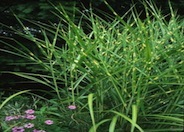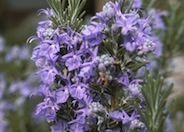
Common name:Zebra Grass
Botanical name:Miscanthus sinensis 'Zebrinus'
This grass can grow up to 6' in height and 3-4 feet in width. This variety has a white stripe on the leaf traveling horizontally.

Common name:Tuscan Blue Upright Rosemary
Botanical name:Rosmarinus officinalis 'Tuscan Blue'
The upright Rosemary is an upright shrub that grows 3-6 ft. tall. It has dark green leaves and bright showy lavender-blue flowers throughout the year. This shrub is drought tolerant and attracts butterflies. -Cornflower Farms

Common name:Chinese Pistache
Botanical name:Pistacia chinensis
The Pistacia chinensis is a deciduous tree with broad, spreading growth to 50' in height. Its leaves have 10-16 leaflets, and the fall coloring arrives in beautiful shades of red, orange and yellow.
The young trees are often gawky, but some become shapely with age. Berries on female trees, when pollinated, are messy.

Common name:Mexican Bush Sage
Botanical name:Salvia leucantha
The Mexican sage is a bushy shrub that grows 3-4 ft. tall and wide. It has hairy white stems, gray-green leaves and velvet like purple flower spikes that bloom summer through fall. This shrub tolerates sun, light shade, little water, and is hardy to 15 degrees F. The Mexican sage is drought tolerant and attracts hummingbirds. -Cornflower Farms

Common name:White Sage, Sacred White Sage
Botanical name:Salvia apiana
This woody shrub has long stems with silvery white leaves and fragrant white flowers that bloom in the spring. It provides a strong sturctural form as a garden focal point. It can reach 6'H x 6'W.
More than half of the water used at your home is for outside purposes. Studies show that on average, half of the water used outdoors is wasted. The leading cause of waste is incorrectly set and poorly managed irrigation controllers. The second biggest cause of wastage is broken irrigation equipment that goes undetected. There are a few basic things you can do to make a big difference in your water use.
Click in the green box for more information
Designer: Dave Roberts Landscape
Photographer: GardenSoft
Practice grass-cycling by leaving short grass clippings on lawns after mowing, so that nutrients and organic matter are returned to the soil.
Mulching and adding compost to soil can minimize evaporation and help soil absorb and store water.
Drip and other smart irrigation delivers water directly to roots, allowing no excess water for weeds.